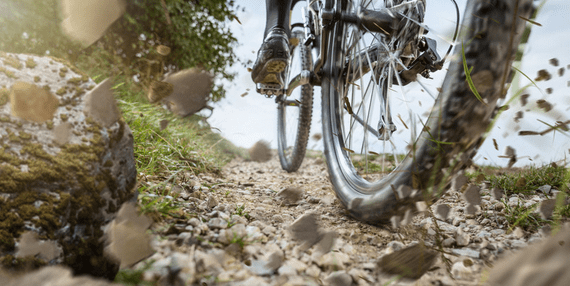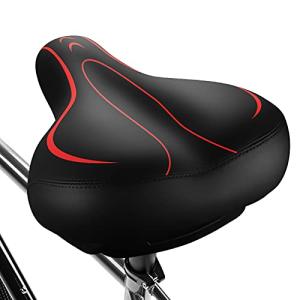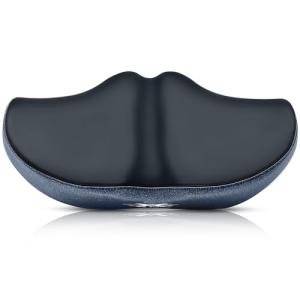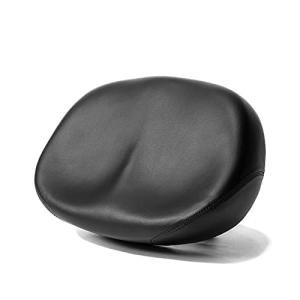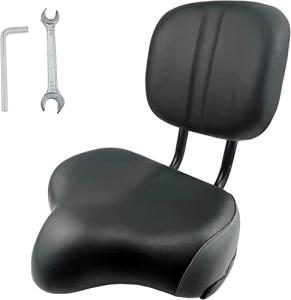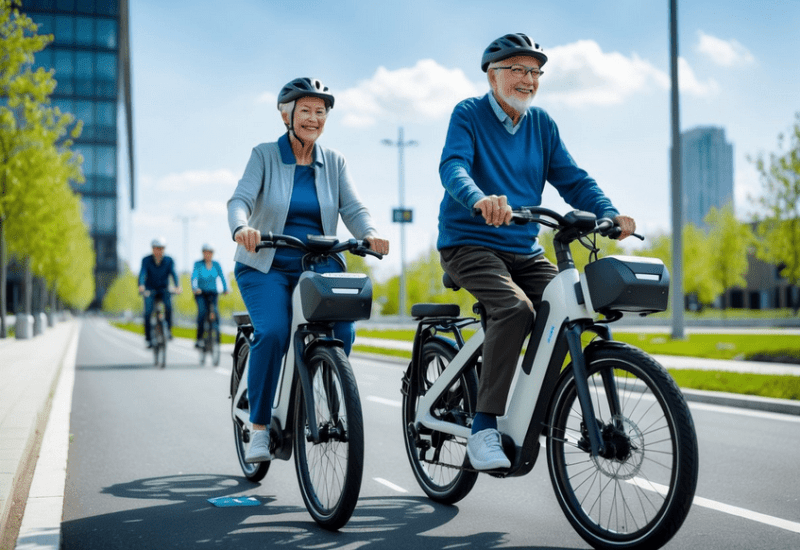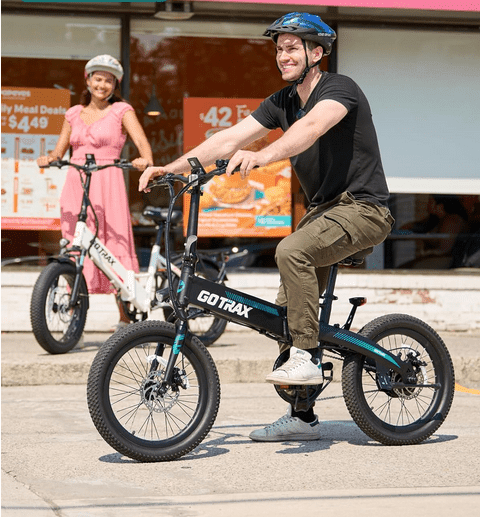Essential Tips for Challenging Terrain:
Riding an electric bike on sand and gravel can be a thrilling adventure. These terrains present unique challenges, but with the right e-bike and techniques, you can enjoy a smooth ride.

Electric bikes with fat tires and sturdy frames are best suited for sand and gravel riding.
Sand can be tricky, especially when it's deep or loose. You'll want to keep your speed steady and avoid sudden movements.
On gravel, watch out for loose rocks and maintain a firm grip on the handlebars. Your e-bike's motor will give you an extra boost, helping you power through tough spots.
Remember to adjust your tire pressure for better traction. Lower pressure works well on sand, while slightly higher pressure is better for gravel.
With practice, you'll get a feel for how your e-bike handles these surfaces and can explore new off-road paths with confidence.
Key Takeaways
- Choose an e-bike with fat tires and a robust frame for sand and gravel riding
- Adjust your riding technique and tire pressure for different surfaces
- Practice regularly to improve your skills and confidence on unstable terrain
Choosing the Right Electric Bike for Sand and Gravel

Fat tire e-bikes and electric gravel bikes are great options for riding on sand and gravel. These bikes have special features that help you tackle rough terrain.
Understanding Different E-Bike Types
Fat tire e-bikes have extra wide tires that work well on soft surfaces like sand. The big tires give you more grip and float over loose ground.
Electric gravel bikes are made for riding on dirt roads and gravel paths. They're lighter than fat tire bikes but still tough enough for bumpy rides.
Mountain bikes can also handle sand and gravel. They have strong frames and good suspension to absorb shocks.
When picking a bike, think about where you'll ride most often. Fat tires are best for sand, while gravel bikes work better on packed dirt.
Features of Fat Tire E-Bikes
Fat tire e-bikes have 4-inch wide tires or larger. This gives you a smooth ride on soft ground.
The electric motor helps you power through sand and up hills. Look for bikes with strong motors, at least 500 watts.
Good suspension is important. Front forks that can move up and down make bumpy rides more comfy.
Fat bikes often have sturdy frames to handle rough terrain. Aluminum is common because it's strong but not too heavy.
Wide handlebars give you more control on loose surfaces. Grippy pedals help keep your feet in place when riding.
Essential E-Bike Components for Rough Terrain

Riding on sand and gravel requires e-bikes with special features. The right parts help you tackle tricky surfaces with ease and safety.
Importance of Fat Tires and Wide Fenders
Fat tires are a must for sand and gravel. They give you better grip and stability. Look for tires that are at least 4 inches wide. These spread your weight over a larger area, stopping you from sinking into soft ground.
Wide fenders keep dirt and water off you and your bike. They should be about 20mm wider than your tires on each side. This extra width catches more spray and debris.
Fat tires and wide fenders work together to make your ride smoother and cleaner.
Battery Power and Motor Performance
A strong battery and motor are key for tough terrain. You need extra power to push through sand and over loose rocks.
Pick a battery with at least 500 watt-hours. This gives you enough juice for longer trips on hard surfaces.
Your motor should have at least 500 watts of power. Mid-drive motors work best for rough ground. They put power right where you need it and help you climb hills.
Remember, more power means shorter battery life. Plan your trips carefully.
Sensors: Torque and Cadence
Sensors help your e-bike respond to how you ride. There are two main types: torque and cadence.
Torque sensors measure how hard you push the pedals. They give power based on your effort. This feels natural and helps save battery on easier ground.
Cadence sensors check how fast you pedal. They're simpler but less precise. They work well on flat areas but can struggle on varied terrain.
For sand and gravel, a torque sensor is best. It gives you smooth power when you need it most, like when starting on soft ground.
Adjusting Your E-Bike Settings for Sand and Gravel
Riding your e-bike on sand and gravel requires some adjustments to your bike's settings. The right setup can make your ride smoother and more enjoyable.
Pedal Assist Modes
Pedal assist modes can help you tackle sandy or gravelly terrain. Most e-bikes have several modes to choose from.
For sand, use a higher assist mode to get more power. This extra boost helps you move through soft sand easier.
On gravel, a medium assist mode often works best. It gives you enough power without making the bike too jumpy.
Try different modes to see what feels right for you. Remember, you can always switch modes while riding if needed.
Some e-bikes have special modes for off-road riding. These can be great for sand and gravel. They often provide smoother power delivery, which helps with traction.
Configuring Electric Assist Levels
You can fine-tune your e-bike's electric assist for different surfaces.
On sand, set your assist level higher. This gives you more power to push through the soft ground. Start at about 70-80% of max assist and adjust from there.
For gravel, a lower assist level often works better. Try starting around 50-60% of max assist. This gives you enough help without making the bike too hard to control on loose surfaces.
Some e-bikes let you change how quickly the motor responds.
For sand and gravel, a gentler response can help. It makes the bike easier to handle on uneven ground. If your bike has this setting, try making the power come on more gradually.
Remember to test your settings in a safe area first. This lets you get used to how your bike behaves before hitting tougher trails.
Riding Techniques for Electric Bikes on Unstable Surfaces
Mastering electric bike riding on sand and gravel takes practice and skill. These tips will help you stay safe and enjoy the ride on tricky terrain.
Managing Weight Distribution on Sandy Terrain
Riding on sand requires careful weight management.
Keep your weight back and slightly off the seat. This helps your rear wheel maintain traction.
Use a low gear and steady pedaling to avoid sinking. Fat tire electric bikes work best on sand due to their wider surface area.
Lean forward slightly when going uphill on sand. This keeps the front wheel from lifting.
When going downhill, shift your weight back to prevent the front wheel from digging in.
Always look ahead and plan your path to avoid deep, soft patches of sand.
Momentum and Top Speed
On unstable surfaces, steady momentum is key.
Start in a low gear and gradually build speed. Once moving, try to keep a constant pace. Sudden changes in speed can cause you to lose control.
Don't push for top speed on sand or gravel. It's safer to go slower and maintain control.
If you hit a patch of deep sand, resist the urge to brake hard. Instead, gently ease off the throttle and let your momentum carry you through.
Use your bike's power assist wisely.
A lower setting often works better on loose surfaces. It gives you more control and helps prevent wheel spin.
Navigating Gravel Roads Safely
Gravel roads present unique challenges.
Look for the smoothest path and avoid loose gravel piles.
Keep a relaxed grip on the handlebars. This helps absorb bumps and prevents overcorrection.
Brake before turns, not during. Apply even pressure to both brakes.
When going downhill, use short, light braking to control your speed. Avoid locking up your wheels, which can cause skids.
Stand up slightly on rough sections. Let your legs act as shock absorbers. This improves control and comfort.
Be extra careful when crossing cattle guards or rail tracks. Approach them at a right angle to avoid getting your wheels caught.
Practical Tips for Maintaining Control

Keeping control of your electric bike on sand and gravel requires proper technique and bike setup. These tips will help you stay safe and enjoy riding on loose surfaces.
Braking Strategies with Hydraulic Disc Brakes
Hydraulic disc brakes offer great stopping power, but need careful use on sand and gravel.
Apply light, steady pressure instead of grabbing the brakes hard. This prevents skidding and loss of control.
Use mostly rear brake on loose surfaces. The front brake can cause the wheel to dig in and slide.
Practice feathering the brakes - gently squeezing and releasing - to slow down smoothly.
Brake before turns, not during. This helps you keep your balance through corners. Let off the brakes as you exit the turn to regain speed.
Adjusting Tire Pressure for Different Terrain
Proper tire pressure is key for traction on sand and gravel.
Lower pressure allows tires to flatten and grip better. But going too low can cause punctures.
For sand, try 10-15 psi in fat tires. This lets them float on top of soft sand.
On hard-packed gravel, keep pressure around 20-25 psi for stability.
Carry a pressure gauge and pump.
Check and adjust pressure often as you switch between surfaces. A tire repair kit is smart to bring along too.
Remember to re-inflate tires before riding on pavement again. Low pressure on hard surfaces can damage rims and reduce handling.
Maintenance and Upkeep for Your E-Bike
Taking care of your e-bike is key for smooth rides on sand and gravel. Regular upkeep and cleaning will keep your bike running well and extend its life.
Regular Maintenance Schedule
Check your e-bike's tire pressure weekly. Low pressure makes riding on sand harder.
Lubricate the chain every 100 miles or after wet rides. This stops rust and keeps things moving smoothly.
Inspect brake pads monthly. Replace them when they get thin. Test your battery once a month. Make sure it charges fully and holds power well.
Every three months, tighten all bolts and screws. Check that nothing is loose. Look at your wheel spokes too. Tighten any that feel slack.
Yearly, take your e-bike to a shop for a full check-up. They'll look at the motor, gears, and electrical parts. This catches problems early.
Cleaning Your E-Bike After Sand and Gravel Rides
Always clean your e-bike after riding on sand or gravel. Start by brushing off loose dirt. Use a soft brush to avoid scratching the paint.
Wash the frame with soapy water and a sponge. Don't use high-pressure water. It can damage electrical parts.
Clean the chain with a degreaser. Then dry it and add fresh oil. This keeps sand from wearing it down.
Wipe the rims and spokes with a damp cloth. Check for any stuck pebbles in the tire treads. Remove them to avoid flats.
Dry your e-bike completely after cleaning. Pay extra attention to electrical parts. Moisture can cause problems if left unchecked.
Safety Considerations and Equipment
Riding an electric bike on sand and gravel requires proper safety gear and preparation. Taking the right precautions will help you enjoy your ride while staying safe.
Protective Gear for the Rider
Always wear a helmet when riding your e-bike. Choose a helmet that fits snugly and meets safety standards.
Gloves protect your hands from blisters and scratches. They also improve your grip on the handlebars.
Wear sunglasses or goggles to shield your eyes from sand, dust, and sun glare. Long sleeves and pants guard against scrapes if you fall.
Closed-toe shoes with good traction are essential for pedaling and walking on loose surfaces.
Consider knee and elbow pads for extra protection, especially when riding on rough terrain. A high-visibility vest or bright clothing helps other riders and vehicles see you clearly.
Emergency Repair Kit Essentials
Pack a basic repair kit for your e-bike rides on sand and gravel. Include a spare inner tube that fits your tire size. Bring tire levers to help remove the tire if you get a flat.
Carry a portable pump or CO2 inflator to refill your tires. A multi-tool with various Allen wrenches and screwdrivers can handle most quick fixes.
Include a chain lube to keep your drivetrain running smoothly in dusty conditions.
Pack a few zip ties and duct tape for temporary repairs. Don't forget a small first-aid kit with bandages and antiseptic wipes. Bring a fully charged phone and some cash for emergencies.
Advanced Riding Techniques and Training
E-bike riding on sand and gravel requires special skills. You can master these terrains with practice and the right techniques.
Building Skills on Hard-packed Sand
Start on hard-packed sand to get comfortable. Keep your weight centered and slightly back on the bike.
Lean forward a bit when going uphill. Use a lower tire pressure for better traction.
Practice turning smoothly by looking where you want to go. Avoid sudden movements that could cause skids.
Pedal steadily to maintain momentum. Try small obstacles like shallow dips or gentle slopes.
This helps you learn how the bike handles on uneven ground. Gradually increase speed as you gain confidence.
Work on your balance by riding in a straight line at slow speeds. This improves control on loose surfaces. Use wider turns to prevent the front wheel from washing out.
Frequently Asked Questions
Electric bikes can handle sand and gravel with the right setup and techniques. Proper tires, bike maintenance, and riding skills make a big difference. Let's look at some common questions about e-biking on these tricky surfaces.
What are the best electric bikes for beach and sand riding?
Fat tire electric bikes work well on sand. They have wide tires that spread out your weight. This helps you float on loose sand instead of sinking in. Look for e-bikes with at least 4-inch wide tires for beach riding.
How do you navigate an electric bike over loose gravel and sand?
Keep a steady pace on loose surfaces. Don't brake or turn suddenly. Lean back slightly to keep weight on your rear wheel. This improves traction.
Lower your tire pressure a bit for better grip. Start with small pressure drops until you find what works.
What maintenance should be performed after riding an e-bike on the beach?
Rinse your e-bike with fresh water after beach rides. This removes salt and sand. Dry it well and oil the chain. Check for sand in moving parts. Clean and lubricate as needed. Inspect electrical parts to make sure sand hasn't gotten inside.
Are there specific regulations for riding electric bikes on beaches?
Beach e-bike rules vary by location. Some beaches ban all bikes. Others allow only certain types.
Check local laws before riding. Some areas have speed limits or restrict where you can ride. Respect wildlife and other beachgoers.
How can you improve traction when riding an electric bike on sandy terrain?
Lower your tire pressure for more surface contact. This helps you float on sand. Try different pressures to find what works best.
Ride in a straight line when possible. Avoid sharp turns that can cause your tires to dig in and lose traction.
What are the advantages of fat tire electric bikes on sand and gravel?
Fat tires provide better stability and traction on loose surfaces. They spread your weight over a larger area. This prevents sinking in sand.
The extra width also helps smooth out bumpy gravel paths. Fat tire e-bikes often have stronger motors to handle the extra weight and resistance.
DISCLAIMER
This document is provided for general information purposes only and should not be relied upon as providing legal advice, technical, or specific operational guidance to the reader, whether as to the practices described in the document or the applicable legal requirements and regulations. justelectricbikes.com expressly disclaims any responsibility for liability arising from or related to the use or misuse of any information in this document.
